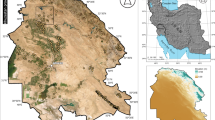Abstract
The technique of karst susceptibility assessment in the territory of Ust-Kishert village is presented. The environmental conditions of predominantly gypsum and carbonate–gypsum karst area are analyzed. The zonation map of karst cavities and crushed zones density is created. The distribution of the overlying soil geotechnical property values within the classes of different subterranean karst form density is carried out and presented in the form of histograms and distribution curves. The computer simulation of the soil stress condition is used to demonstrate that karst cavity affects the mechanical properties of the overlying soils and alters the initial stress in the soils. In our research, the anomalous values of the overlying soil geotechnical properties are applied as the indicators of the karst cavities and crushed zones location. The anomalous value intervals are determined by one-dimensional statistical analysis. The analysis of the overlying soil geotechnical properties is resulted in the integral model of karst susceptibility in the research area.













Similar content being viewed by others
Notes
Kataev V.N. Report on the research work "Monitoring of the karst territories of the Perm Region", Perm, 2010.
References
Anikeev AV (2017) Sinkholes and subsidence of the earth's surface in karst areas: mechanisms of formation, forecast and risk assessment. RUDN, Moscow (in Russian)
Brinkmann R, Wilson K, Elko N, Seale LD, Florea L, Vacher HL (2007) Sinkhole distribution based on pre-development mapping in urbanized Pinellas County, Florida, USA. From: Parise, M. & Gunn, J. (eds) Natural and Anthropogenic Hazards in Karst Areas: Recognition, Analysis and Mitigation. Geological Society, London, Special Publications, 279:5–11. Doi: 10.1144/SP279.2
Churinova MV (ed) (1968) Reference book on engineering geology. Nedra, Moscow (in Russian)
Dreybrodt W (2006) Dissolution: evaporite rocks. In: Gunn J (ed) Encyclopedia of caves and karst science. Fitzroy Dearborn, New York, pp 617–621
Drobinina E, Kovaleva T, Koriakina A (2018) Investigation of the local variation of physical and mechanical properties of the covering deposits in order to hazard assessment of karst (on the example of sulfate-carbonate karst of Permsky kray, Russia). In: Symposium KARST 2018—expect the unexpected. Trebinje, pp 135–142
Drobinina EV (2016) Investigation of local changes of physical and mechanical properties of overlying soils as indicators of the disintegration of rocks zone in the karst massif. In: Problems of geology and subsoil development, Tomsk, pp 548–550 (in Russian)
Ford DC, Williams P (2007) Karst hydrogeology and geomorphology. Wiley, Chichester
Gorbunova KA, Andreychuk VN, Kostarev VP (1992) Maksimovich NG. Karst and caves of the Perm region, Perm (in Russian)
Gutiérrez F, Cooper AH (2013) Surface morphology of gypsum karst. In: Frumkin A (ed) Treatise on geomorphology, vol 6. Elsevier, Amsterdam, pp 425–437
Gutiérrez F, Parise M, De Waele J, Jourde H (2014) A review on natural and human-induced geohazards and impacts in karst. Earth Sci Rev 138:61–88. https://doi.org/10.1016/j.earscirev.2014.08.002
Kataev VN (2004) Fundamentals of structural karstology. PSU, Perm (in Russian)
Kataev VN (1994) System approach in the stability of karst massifs analysis. Bull Perm Univ Geol Issue 3:127–144 (in Russian)
Kaufmann G (2014) Geophysical mapping of solution and collapse sinkholes. J Appl Geophys 111:271–278
Khomenko VP (2015) Karst sinkhole formation: mechanism and hazard assessment. In: Environmental safety and construction in karst areas. Proceedings of the international symposium. Russia, Perm, pp 50–60 (in Russian)
Kovaleva TG (2015) The results of the karst hazard assessment of the carbonate-sulfate karst areas on the basis of geological and hydrogeological factors. In: Environmental safety and construction in karst areas. Proceedings of the international symposium. Russia, Perm, pp 173–176 (in Russian)
Kutepov VM (1986) The stability of karst areas assessment by the method of stress analysis of rock massifs Overview and recommendations. TSP NTGO, Moscow (in Russian)
Margiotta S, Negri S, Parise M, Quarta TAM (2016) Karst geosites at risk of collapse: the sinkholes at Nociglia (Apulia, SE Italy). Environ Earth Sci 75(1):1–10. https://doi.org/10.1007/s12665-015-4848-y
Milanović P (2018) Karst Hydrogeology. Belgrade
Nisio S, Caramanna G, Ciotoli G (2007) From: PARISE, M. & GUNN, J. (eds) Natural and anthropogenic hazards in karst areas: recognition, analysis and mitigation. Geological Society, London, Special Publications, 279, 23–45. DOI: 10.1144/SP279.4
Paniukov PN (1962) Engineering geology. Gosgortekhizdat, Moscow (in Russian)
Parise M (2015) A procedure for evaluating the susceptibility to natural and anthropogenic sinkholes. Georisk 9(4):272–285
Parise M, Closson D, Gutiérrez F, Stevanović Z (2015) Anticipating and managing engineering problems in the complex karst environment. Environ Earth Sci 74:7823–7835. https://doi.org/10.1007/s12665-015-4647-5
Postoev GP (2013) The limit state and deformation of soils in the massif (landslides, sinkholes, ground base subsidence. Sankt-Peterburg, Moscow (in Russian)
Shcherbakov SV, Kataev VN (2013) Towards assessment of morphometric characteristics of karst forms. In: Engineering geology, vol 1. PNIIIS, Moskow, pp 56–64 (in Russian)
Shilova AV, Kovaleva TG (2015) Influence of overlying mass on the development of karst forms on the example of the Ust-Kishert village, the Perm region. In: Environmental safety and construction in karst areas. Perm, pp 351–355 (in Russian)
Terzaghi K (1996) Soil mechanics in engineering practice, 3rd edn. New York
Varnes DJ (1984) Landslide hazard zonation: a review of principles and suggested practice. UNESCO, Paris
Waltham T, Lu Z (2007) Natural and anthropogenic rock collapse over open caves. In: Parise M, Gunn J (eds) Natural and anthropogenic hazards in karst areas: recognition, analysis and mitigation, vol 279. Geological Society Special Publications, London, pp 13–21. https://doi.org/10.1144/SP279.3
Waltham T, Bell F, Culshaw M (2005) Sinkholes and subsidence: karst and cavernous rocks in engineering and construction. Springer, Berlin
Zhou W, Beck BF (2011) Engineering issues on karst. In: van Beynen P (ed) Karst management. Springer, Dordrecht, pp 9–45. https://doi.org/10.1007/978-94-007-1207-2_2
Author information
Authors and Affiliations
Corresponding author
Additional information
Publisher's Note
Springer Nature remains neutral with regard to jurisdictional claims in published maps and institutional affiliations.
Rights and permissions
About this article
Cite this article
Drobinina, E., Kovaleva, T. & Koriakina, A. The local variation of the overlying soils geotechnical properties in the karst susceptibility assessment. Carbonates Evaporites 35, 79 (2020). https://doi.org/10.1007/s13146-020-00615-3
Accepted:
Published:
DOI: https://doi.org/10.1007/s13146-020-00615-3




